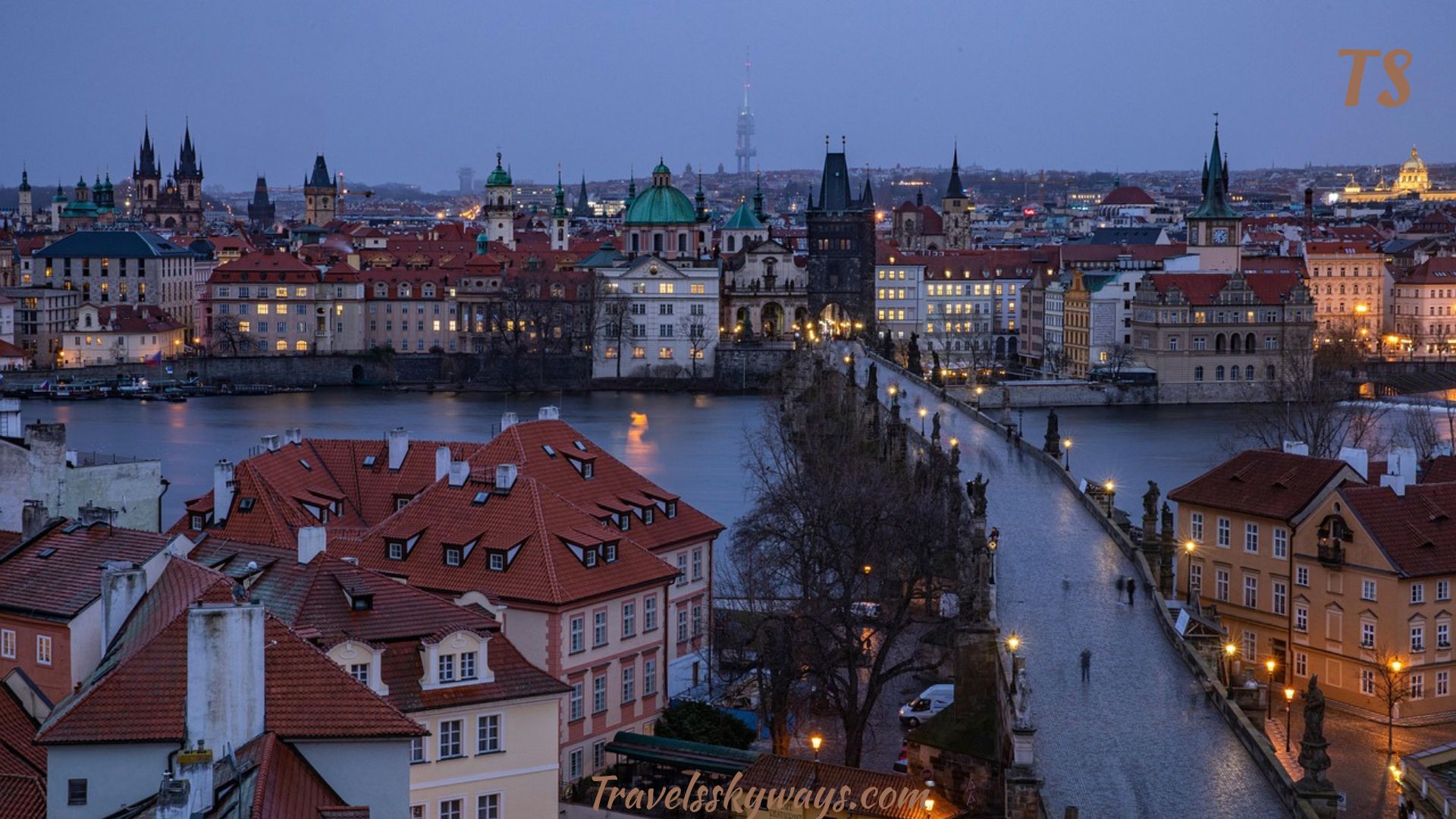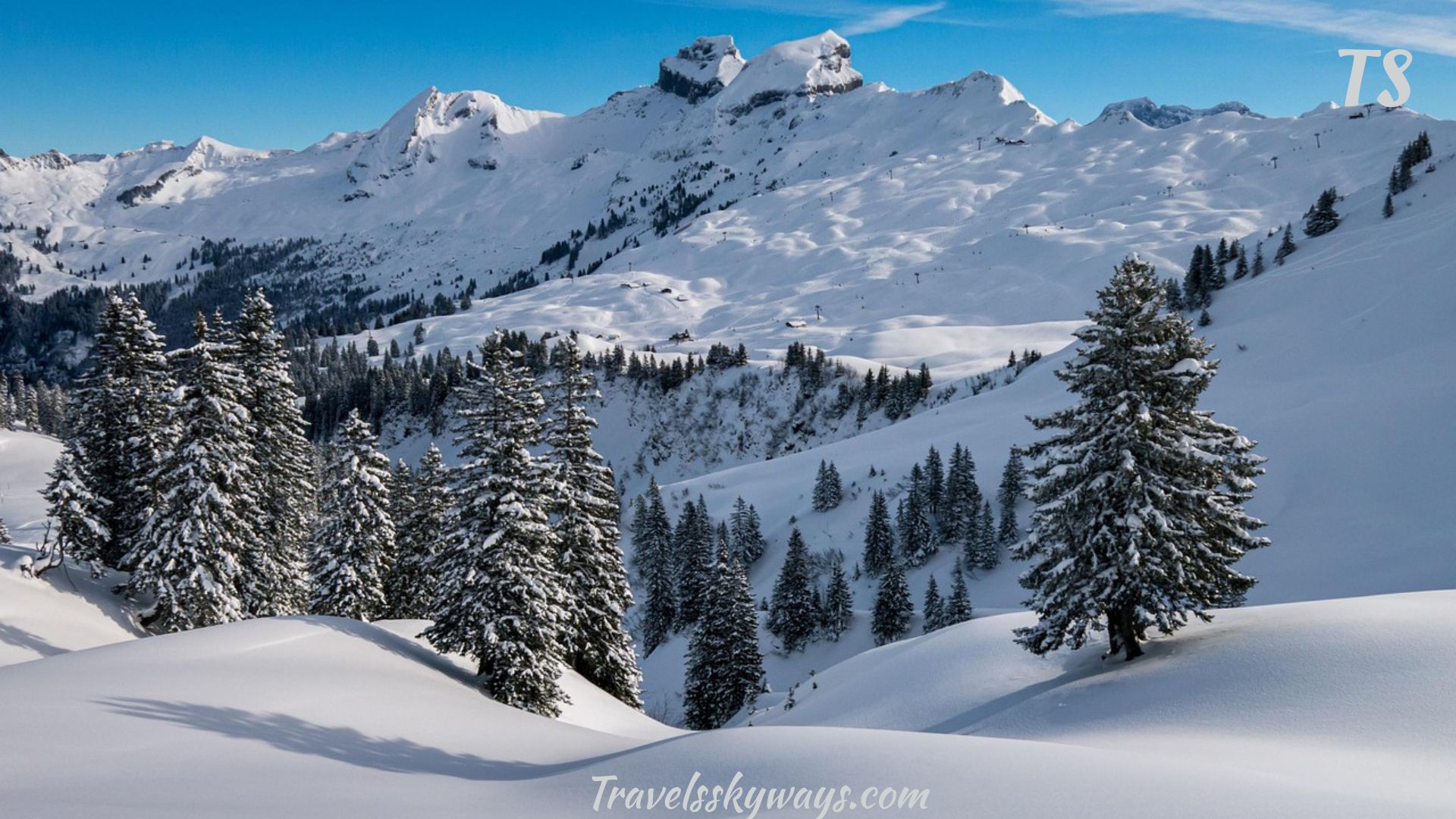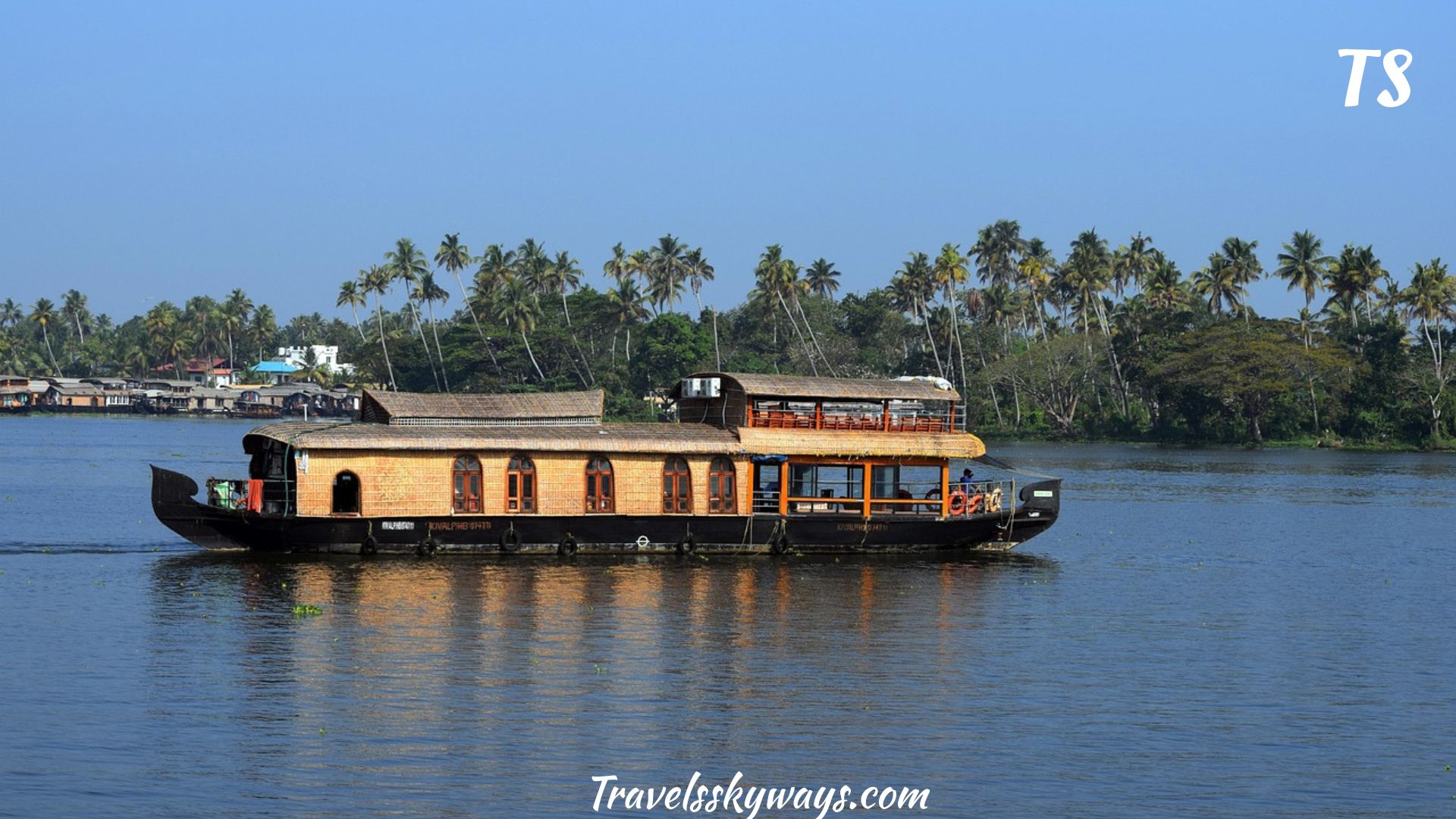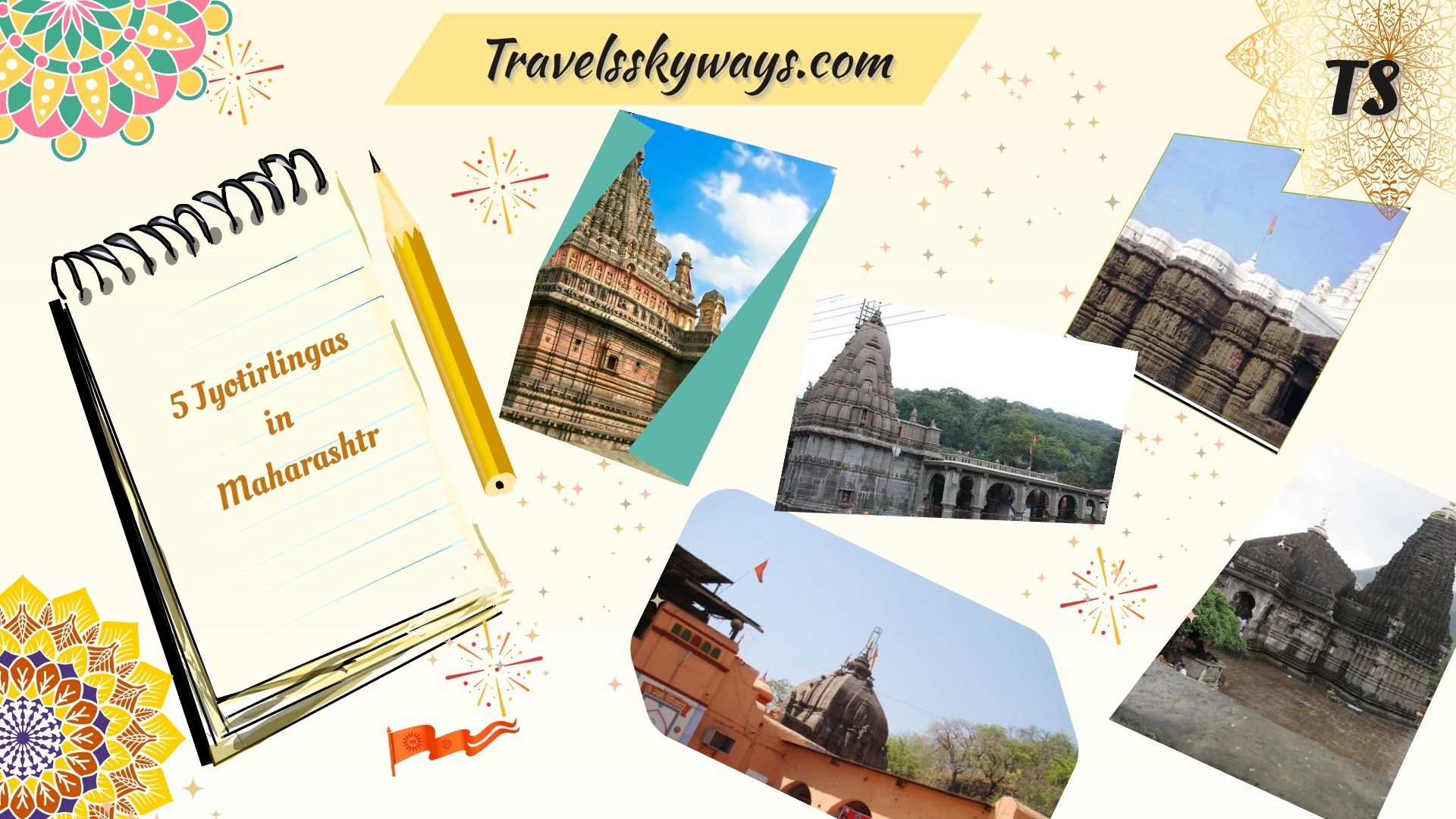
Here are the Sacred 5 Jyotirlingas of Maharashtra, a divine pilgrimage to the very heart of the most powerful manifestations of Shiva. These temples, luring millions for spiritual cure, peace, and blessings, are woven into strange ancient legends and have breathtaking architecture surrounding them.
Whether you visit the esoteric Trimbakeshwar, which boasts of India’s only three-headed Shivling, or the sedate Grishneshwar just outside the cave complexes of Ellora place has a different feel.
Devout pilgrims and casual sightseers alike would definitely take home their share of unforgettable experiences that are part and parcel of exploration through these Jyotirlingas spread all across Maharashtra. Let it begin!
Jyotirlingas in Maharashtra
Unlock the divine trail of the 5 sacred Jyotirlingas in Maharashtra—each one a powerful symbol of Lord Shiva’s eternal presence. These revered shrines aren’t just places of worship; they’re spiritual powerhouses steeped in ancient legend and myth.
From the majestic Trimbakeshwar Jyotirlinga near Nashik to the deeply spiritual Grishneshwar Temple near Ellora, each temple echoes centuries of devotion. Pilgrims and history lovers alike are drawn to their awe-inspiring architecture, mystical aura, and mythological significance.
For example, the Bhimashankar Jyotirlinga, nestled in the Sahyadri hills, is not just a holy site—it’s a nature lover’s paradise, wrapped in thick forests and rare wildlife. Whether you’re seeking spiritual growth, cultural richness, or simply a journey through India’s divine heritage, the Jyotirlingas in Maharashtra offer a path that’s both sacred and unforgettable.
Trimbakeshwar Jyotirlinga (Nashik)
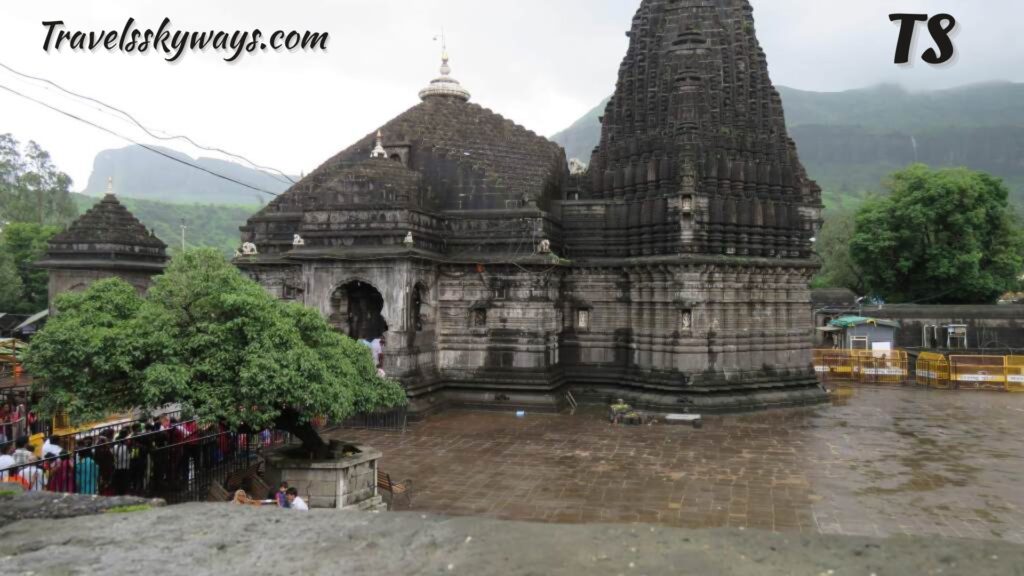
Prepare to be awed at Trimbakeshwar Jyotirlinga (Nashik)—one of the rare temples in India where the Shivlinga reveals three faces, symbolizing Brahma, Vishnu, and Mahesh.
Built in the elegant Hemadpanthi-Nagara architectural style by Peshwa Balaji Baji Rao in the 18th century, the temple’s striking black basalt stone design reflects both artistry and unwavering devotion. Located about 28 km from Nashik city, it rests peacefully at the base of Brahmagiri Hill, the sacred birthplace of the Godavari River.
Recent upgrades have elevated its significance—Trimbakeshwar has been granted Class A pilgrimage center status, and a ₹277 crore development plan is underway. This includes a modern pilgrims’ complex, wider roads, expanded parking, and improved facilities in preparation for the upcoming Simhastha Kumbh Mela (2026–28).
During the auspicious Shravan Somvar (Mondays in the Shravan month), the temple experiences a massive influx of crowds, prompting authorities to deploy around 600 personnel for traffic and safety management.
Whether you’re seeking spiritual peace, renewal of faith, or a deep dive into India’s sacred heritage, Trimbakeshwar Jyotirlinga offers a timeless experience that continues to evolve with every passing generation.
Best Time to Visit Trimbakeshwar Jyotirlinga
🌤 Ideal Months: October to March
- Weather: Cool and pleasant (15°C to 30°C)
- Why Go Now: Perfect for exploring the temple and nearby attractions like Brahmagiri Hill and the Godavari origin point without the discomfort of heat or heavy rains.
- Tip: These months are also less crowded compared to peak religious dates.
🛕 Spiritual Peak: July to August (Shravan Month)
- Occasion: Shravan Somvar (Mondays of Shravan) and Nag Panchami
- Experience: High-energy devotion, chants, long queues, and a spiritual buzz like no other.
- Crowd Level: Extremely high. Expect wait times and traffic.
- Tip: If you’re visiting during this time, go early in the morning and avoid weekends.
🌧 Monsoon Months: June to September
- Pros: Lush greenery, waterfalls, and a mystical ambiance around the temple and hills.
- Cons: Slippery trails on Brahmagiri, and intermittent rain can slow down travel.
🔥 Avoid: April to May
- Reason: Summer temperatures can soar above 40°C.
- Impact: Heat makes darshan and outdoor exploration exhausting.
Quick Travel Tips
- Darshan Timings: 5:30 AM to 9:00 PM daily
- Photography: Not allowed inside the sanctum
- Footwear: Must be removed outside temple premises
- Advance Pooja Bookings: Available online via the official temple site or trusted local guides
Sample 2‑Day Itinerary
| Day | Morning | Midday & Afternoon | Evening / Night |
|---|---|---|---|
| Day 1 | Arrive in Nashik → travel to Trimbakeshwar | Darshan at Trimbakeshwar Jyotirlinga, visit Kushavarta Kund, Brahmagiri Hill (source of Godavari) | Stay near temple; attend evening aarti or temple rituals |
| Day 2 | Trek or visit Anjaneri Fort / Hills | Return to Nashik → explore Panchavati: Kalaram Temple, Sita Gufa, Ram Kund, Muktidham | Stay near the temple; attend evening aarti or temple rituals |
Accommodation Suggestions Near Trimbakeshwar
Staying near the temple is the best way to catch early morning rituals, avoid crowds, and enjoy the tranquil surroundings. Here are some reliable lodging options:
- Shree Swami Samarth Lodge – Just 300 meters from the temple. A basic but clean and affordable place for pilgrims.
- Kuber Guest House – A solid budget-midrange option offering decent comfort at reasonable rates.
- Hotel Trimbak Residency – Located about 0.5 km away, this hotel has more amenities for families and comfort-seekers.
- Gautami Residency – Around 1 km from the temple. Features include a vegetarian restaurant and pickup/drop service for temple visits.
- Dharamshalas and Guest Houses – Places like Someshwar Dharamshala and Gajanan Dharamshala cater to pilgrims seeking low-cost or spiritual stays with simple facilities.
👉 Booking Tips:
- Book early, especially during the Shravan month (July–August) and major festivals like Mahashivratri.
- Always check amenities in advance: hot water, clean bedding, meal availability, and temple shuttle options.
- Some places offer pilgrimage packages that include meals, guided temple visits, and local sightseeing—ask during booking.
Nearby & Must‑See Spots Around Trimbakeshwar / Nashik
| Place | Why Visit | Notes / Tips |
|---|---|---|
| Kushavarta Kund | Sacred pond where pilgrims bathe before darshan | Located within the temple complex |
| Brahmagiri Hill | Origin of the Godavari River, scenic trek | Moderate walk; best attempted early morning |
| Anjaneri Fort / Hills | Trek with caves and Hanuman birth mythology | About 20 km from Trimbak; carry water, wear shoes |
| Panchavati (Nashik) | Historic zone: Kalaram Temple, Sita Gufa, etc. | A stunning natural waterfall, especially in the monsoon |
| Dugarwadi Waterfall | Trek with caves and the Hanuman birth mythology | Rich in spiritual history, good for a half-day trip |
Transport Tips
- Private car: Best for comfort and flexible stops.
- Train options: Use for long stretches (like Nashik to Aurangabad) and then switch to cabs.
- State buses: Affordable but may lack comfort and direct routes to all shrines.
- Avoid night travel in hilly or remote areas like Bhimashankar.
Bhimashankar Jyotirlinga (Pune)

Hidden deep in the Sahyadri hills, Bhimashankar Jyotirlinga stands as a powerful blend of spiritual energy and natural beauty. Located about 110 km from Pune, this sacred site is one of the 12 Jyotirlingas in India, drawing devotees, trekkers, and peace seekers alike.
The temple, built in the classic Nagari style, dates back to the 13th century, though legends claim the jyotirlinga existed long before. Surrounded by the dense Bhimashankar Wildlife Sanctuary, the region teems with biodiversity—including the rare Malabar giant squirrel (Shekru), Maharashtra’s state animal.
Inside the temple, the Shivlinga is naturally formed, resting in a quiet, dimly lit sanctum that humbles even the most seasoned traveler. The river Bhima is said to originate here, adding sacred geography to its already divine status.
Reaching the temple involves a scenic drive, followed by a short walk or a few hundred steps, depending on your entry route. Monsoon and winter months (June to February) offer the best experience, when mist hangs over the hills and the entire valley turns lush green.
Whether you’re drawn by faith, folklore, or the sheer beauty of the Western Ghats, Bhimashankar offers a journey that stirs both the heart and the spirit.
Bhimashankar Jyotirlinga Travel Guide
📍 Location
Bhimashankar Jyotirlinga is located in the Sahyadri Hills of Maharashtra, around 110 km from Pune and about 220 km from Mumbai. It’s nestled inside the Bhimashankar Wildlife Sanctuary, making it a unique blend of pilgrimage and eco-tourism.
How to Reach Bhimashankar
From Pune:
- By road (car or taxi): Approx. 3 to 4 hours via Manchar or Chakan.
- By public transport: Take an ST bus from Shivajinagar Bus Stand or Pune Station to Bhimashankar (limited services, check timings in advance).
From Mumbai:
- Drive via the Kalyan–Murbad–Junnar route (6 to 7 hours).
- You can also take a train to Pune, then continue by road.
Roads to Bhimashankar can be narrow and winding—especially near the ghat sections—so drive cautiously.
Trekking Routes to Bhimashankar
Love adventure? You can trek to Bhimashankar through two scenic routes:
1. Ganesh Ghat Trek
- Start point: Karjat or Khandas village
- Time: 4–5 hours
- Difficulty: Moderate
- Features: Dense forest, ladders, waterfalls, bird calls
2. Shidi Ghat Trek
- Steeper and riskier, not recommended for monsoons
- Includes steep rock patches and ladders
Trekking is best done from October to February, when weather is cool and visibility is clear.
Accommodation Near Bhimashankar
Staying overnight gives you time for a peaceful morning darshan and a chance to explore the forest.
🔹 Recommended Stays:
- Blue Mormon Jungle Holiday Resort – A comfortable option inside the forest zone.
- MTDC Bhimashankar – Basic state-run resort with decent amenities.
- Private homestays & lodges – Available in Bhorgiri, Ghodegaon, and nearby villages.
Booking Tips:
- Reserve early during Shravan, Mahashivratri, and long weekends.
- Confirm hot water, power backup, and meal options before booking.
Places to See Around Bhimashankar
| Place | Why Visit | Distance from Temple |
|---|---|---|
| Gupt Bhimashankar | Hidden shrine in the forest | ~2 km (easy walk) |
| Hanuman Lake | Peaceful spot surrounded by trees | ~1 km |
| Nagphani Point | Trek to this cliff for amazing sunrise views | ~3–4 km |
| Bhimashankar Wildlife Sanctuary | Rich biodiversity—great for birdwatchers and photographers | All around |
Tips for Pilgrims and Travelers
- Weather: The Best time is from October to February. Avoid trekking in heavy monsoon unless you’re experienced.
- Clothing: Wear modest, comfortable clothes. Carry a shawl or sweater—mornings are chilly.
- Footwear: Trekking or sports shoes with grip are a must.
- Darshan timing: Early morning (before 9 AM) is best to avoid queues.
- Food: Small local eateries offer simple vegetarian meals. Carry dry snacks and bottled water.
Experience Highlights
- Meditate in the sanctum where Lord Shiva is believed to have slain the demon Tripurasura.
- Hear forest chants, temple bells, and the flow of the Bhima River nearby.
- Watch fog roll through the jungle, especially in early mornings—pure bliss.
Grishneshwar Jyotirlinga (Aurangabad)
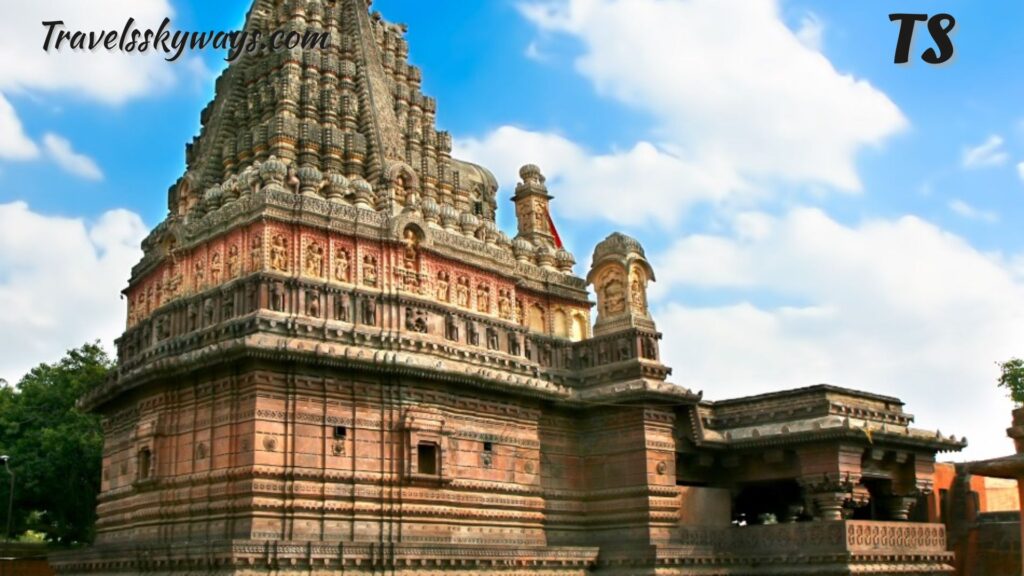
Grishneshwar Jyotirlinga holds a sacred place as the 12th and final Jyotirlinga in India’s divine circuit. Located near Ellora Caves in the Aurangabad district of Maharashtra, this ancient temple is a spiritual treasure nestled in history. Though modest in size, its spiritual aura is immense.
The temple was rebuilt in the 18th century by Ahilyabai Holkar, the legendary queen of the Holkar dynasty, who also restored many sacred shrines across India. Crafted in traditional Maharashtrian temple architecture, its red stone structure features beautiful carvings, arched corridors, and a five-tiered shikhara. The atmosphere inside is quiet yet powerful—devotees often feel a deep spiritual pull here.
Unlike many Jyotirlingas, Grishneshwar allows men to enter the sanctum sanctorum shirtless, following an age-old ritual. The Shivlinga rests slightly below ground level, constantly bathed in holy water—a symbol of Shiva’s eternal presence.
The temple sits just 1 km from Ellora Caves, a UNESCO World Heritage site featuring stunning rock-cut Buddhist, Hindu, and Jain monuments. You can easily combine both visits in a single day.
How to Reach Grishneshwar Jyotirlinga
- From Aurangabad city: Just 30 km away, about 45 minutes by road.
- From Ellora: A quick 5-minute drive or even a walk.
- By air/train: Aurangabad has a domestic airport and a major railway station with good connections across Maharashtra and India.
Suggested Time & Darshan Tips
- Best time to visit: October to March (cool, pleasant weather).
- Ideal darshan hours: Early morning or late evening for fewer crowds.
- Allocate 1–2 hours for temple rituals and nearby exploration.
- Combine with Ellora Caves for a day filled with both spiritual depth and historical marvels.
Stay Options Near Grishneshwar / Ellora
- MTDC Resort Ellora – Government-run, located right near the caves.
- Budget lodges – Available in Verul (Ellora) village.
- Aurangabad city – Offers everything from budget hotels to luxury stays like 3-star and heritage hotels. Staying here also gives access to other famous sites.
Nearby Places to Visit
| Place | Highlights | Distance |
|---|---|---|
| Ellora Caves | 34 rock-cut temples including Kailasa Temple | ~1 km |
| Daulatabad Fort | Historic hill fort, panoramic views | ~15 km |
| Bibi Ka Maqbara | Mughal-era tomb, “Mini Taj Mahal” | ~30 km |
| Panchakki | Ancient water mill and shrine | ~32 km |
Travel & Pilgrimage Tips
- Footwear is not allowed beyond the temple entry—carry a bag to store your shoes.
- Dress conservatively; men may need to remove shirts before entering the sanctum.
- Avoid Sundays and major festivals if you want a quiet darshan.
- Combine your visit with Trimbakeshwar, Aundha Nagnath, or Parli Vaijnath for a more complete Jyotirlinga circuit in Maharashtra.
Grishneshwar may be the smallest of the twelve, but its spiritual significance, historical background, and proximity to Ellora make it an unforgettable experience—both soul-stirring and culturally rich.
Aundha Nagnath Jyotirlinga (Hingoli)
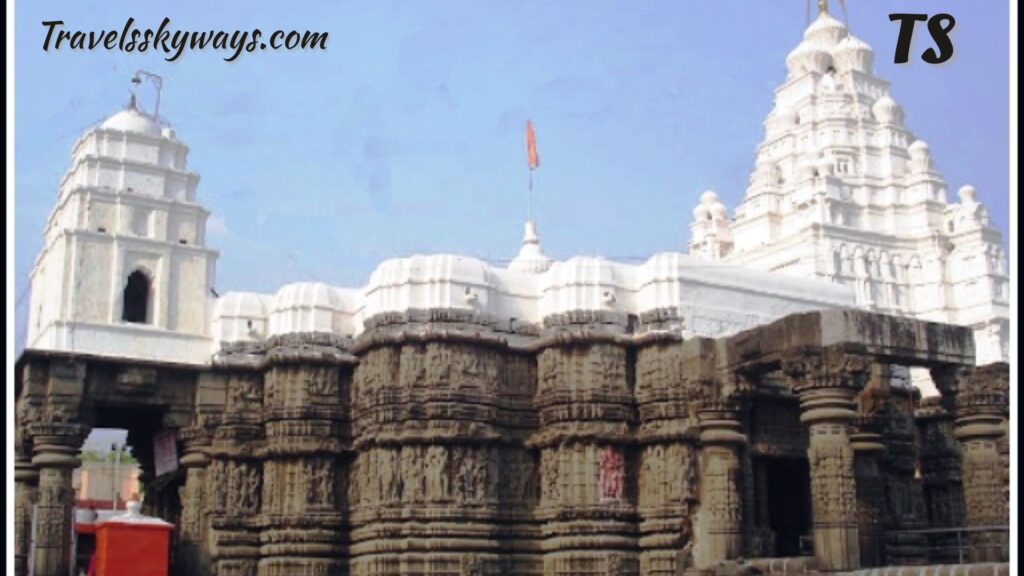
Aundha Nagnath Jyotirlinga is often described as the first and foremost Jyotirlinga—believed to be the original one where Lord Shiva was worshipped in the form of Nageshwar. Located in the Hingoli district of Maharashtra, this ancient temple isn’t just spiritually significant; it’s also a remarkable example of Hemadpanthi architecture from the 13th century.
The temple is surrounded by legend and mystery. According to mythology, even Yudhishthira and his brothers are said to have visited Aundha Nagnath during their exile. What makes this temple unique is the underground sanctum, where the Shivlinga lies submerged, and Nandi is placed off-center—facing away from the deity, which is rare in Shiva temples. Locals say it’s because of a story where Nandi turned in rage when Lord Shiva was disturbed during meditation.
The temple complex is massive, built with black stone and covered in elaborate carvings of gods, goddesses, and scenes from the epics. Despite its grandeur, the atmosphere here feels peaceful, grounded, and deeply rooted in devotion. You don’t just see the temple—you feel it.
How to Reach Aundha Nagnath
- Nearest town: Aundha Nagnath, in Hingoli district, Maharashtra.
- By road: Well-connected by buses and taxis from Parbhani, Nanded, and Aurangabad.
- Nearest railway station: Hingoli (17 km) or Parbhani (50 km).
- By air: The Nearest airport is Nanded, about 75 km away.
Best Time to Visit & Darshan Tips
- Visit during October to March for cooler weather.
- Morning hours (6 AM to 10 AM) are best for peaceful darshan.
- During Shravan, Mahashivratri, and Nag Panchami, expect large crowds and vibrant rituals.
Where to Stay
- Local lodges and dharamshalas are available in Aundha town for basic stays.
- For better amenities, stay in Hingoli or Nanded, both within easy driving distance.
- Some temple lodges offer simple vegetarian meals and guided temple tours—ask when booking.
Nearby Places to Explore
| Place | Why Visit | Distance |
|---|---|---|
| Sant Namdev Sansthan | Dedicated to the 13th-century saint-poet Namdev | ~1 km |
| Nanded (Hazur Sahib) | Major Sikh pilgrimage site | ~75 km |
| Parbhani Temples | Known for Balaji Mandir and Jamb Samarth Ashram | ~50 km |
Tips for Pilgrims
- Footwear, phones, and cameras aren’t allowed inside the sanctum—lockers are available.
- Dress modestly; temple customs are strictly followed.
- Carry cash, as digital payments may not work everywhere.
- The temple sees less commercial tourism, making it ideal for those seeking authentic spiritual peace.
If you’re tracing the path of the 12 Jyotirlingas, Aundha Nagnath deserves a place high on your list—not just for its historical and religious weight, but for the quiet divinity it offers in a world that rarely slows down.
Parli Vaijnath Jyotirlinga (Beed)
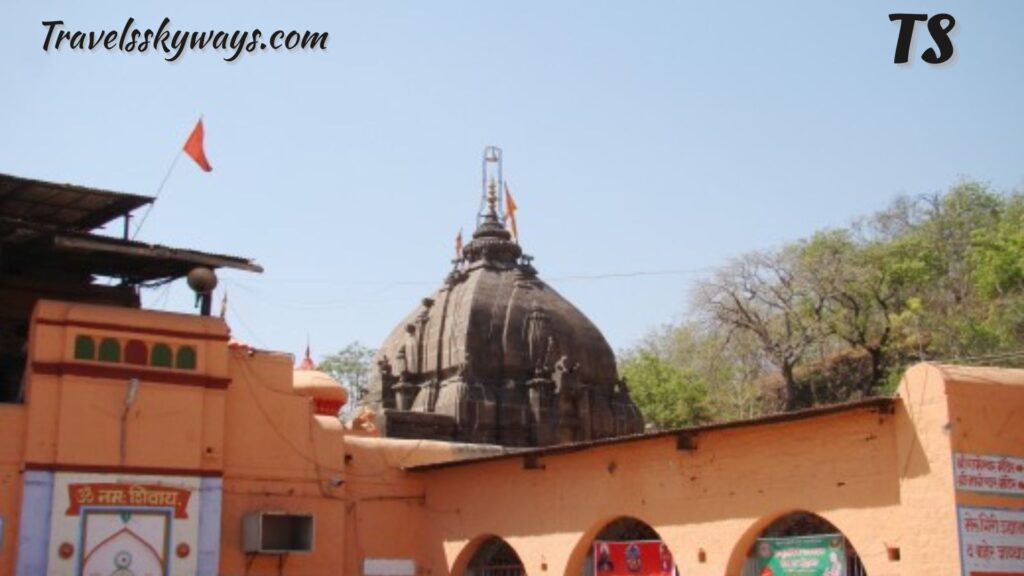
Parli Vaijnath Jyotirlinga, nestled in the Beed district of Maharashtra, is revered as one of the 12 Jyotirlingas of Lord Shiva and carries immense healing and spiritual significance.
Locals believe that the very name “Vaijnath” stems from “Vaidya”, meaning doctor, because Shiva here is worshipped as the Divine Healer, capable of curing both physical ailments and emotional suffering. The temple stands on a hillock and beautifully blends stone architecture with Maratha-style design, offering a serene setting for devotees.
What sets Parli Vaijnath apart is that both Shiva and Parvati are worshipped together, symbolizing the divine union of energy and consciousness. The Shivlinga is swayambhu (self-manifested), housed in a deep sanctum that radiates stillness. According to legend, the Pandavas once built a guesthouse here during their exile, and Lord Vishnu is said to have bathed in the temple’s sacred waters.
Surrounded by a spacious courtyard, the temple complex is lively yet deeply peaceful, especially during Shravan, Mahashivratri, and Kartik Poornima, when it draws thousands of pilgrims. The holy pond inside is considered especially sacred for ritual baths before darshan.
How to Reach Parli Vaijnath
- By road: Well-connected to cities like Beed, Latur, and Nanded.
- By train: Parli Vaijnath has its own railway station, connected to major towns.
- By air: Nearest airports are Aurangabad (~190 km) and Nanded (~105 km).
Best Time & Darshan Tips
- October to March offers the most comfortable weather.
- Visit early morning or late evening for a peaceful darshan and cooler temperatures.
- Don’t miss Monday Abhishekam and Shravan month rituals—they’re filled with Vedic chants and powerful spiritual energy.
Accommodation Options
- Temple-managed dharamshalas and guesthouses are available within walking distance.
- For more comfortable stays, try hotels in Parli town or nearby Latur.
- Most lodges offer vegetarian meals, temple shuttle services, and guide support if requested.
Nearby Attractions
| Place | Why Visit | Distance |
|---|---|---|
| Sundra Narayan Temple | Beautiful Vishnu temple, linked to Vaijnath legend | ~2 km |
| Shivparvati Cave Temple | Believed to be the meditation spot of Shiv-Parvati | ~5 km |
| Kundalika River Ghats | Peaceful riverbank area, perfect for reflection | ~7 km |
Must Read: Kaanapali Beach Parking
Traveler’s Tips
- Keep footwear, phones, and valuables in lockers before entering.
- Carry cash, as rural areas may not have strong digital payment support.
- Dress respectfully—traditional attire is appreciated during darshan.
- Try to attend evening aarti—the sound, lights, and incense create a powerful atmosphere.
Parli Vaijnath isn’t just a temple—it’s a healing sanctuary, a space where spiritual and physical energies meet. Whether you’re seeking blessings, balance, or inner clarity, this jyotirlinga has a way of reaching deep into your soul.
Must Read: Walking the Kaanapali Beach Walk trail in Maui
General Information
12 Jyotirlingas in India, Including Maharashtra
- Somnath (Gujarat) – The first Jyotirlinga, known as the “Protector of the Moon,” is located on the Arabian Sea coast.
- Mallikarjuna (Andhra Pradesh) – Situated on the sacred Shri Shaila mountain, symbolizing Shiva and Parvati’s divine union.
- Mahakaleshwar (Madhya Pradesh) – A powerful Jyotirlinga in Ujjain, famous for its Bhasma Aarti and fierce form of Shiva.
- Omkareshwar (Madhya Pradesh) – Located on an island shaped like the sacred ‘Om’, this temple blends spirituality and nature.
- Kedarnath (Uttarakhand) – Nestled in the Himalayas, this shrine challenges pilgrims with its high-altitude beauty and devotion.
- Bhimashankar (Maharashtra) – One of the rare Jyotirlingas in Maharashtra, set amidst the lush Sahyadri hills, is also famous for its wildlife sanctuary.
- Kashi Vishwanath (Uttar Pradesh) – Located in Varanasi, the spiritual heart of India, this Jyotirlinga stands on the banks of the holy Ganges.
- Trimbakeshwar (Maharashtra) – Near Nashik, this unique temple features a three-faced Shivling representing Brahma, Vishnu, and Shiva.
- Vaidyanath (Parli Vaijnath) (Maharashtra) – Also called the “Divine Healer,” located in Beed district, Maharashtra, renowned for its healing powers.
- Nageshwar (Aundha Nagnath) (Maharashtra) – The original Jyotirlinga of Lord Nageshwar, found in Hingoli district, with intriguing legends and rituals.
- Ramanathaswamy (Tamil Nadu) – A sprawling temple in Rameswaram, linked to the epic Ramayana and famous for its long corridors.
- Grishneshwar (Maharashtra) – The smallest Jyotirlinga, close to the Ellora caves, is revered for its serene and ancient atmosphere.
📍 Summary: Jyotirlingas in Maharashtra
- Bhimashankar
- Trimbakeshwar
- Vaidyanath (Parli Vaijnath)
- Nageshwar (Aundha Nagnath)
- Grishneshwar
These five Maharashtra Jyotirlingas offer a rich spiritual journey filled with history, devotion, and cultural heritage. Whether you’re a pilgrim or a curious traveler, exploring these temples reveals the many facets of Lord Shiva’s divine presence.
FAQs
Are there any special rituals unique to the Jyotirlingas in Maharashtra?
Yes, many temples have distinct rituals. For example, Trimbakeshwar is famous for the Kumbh Mela held every 12 years, while Bhimashankar hosts special wildlife blessings due to its sanctuary location.
Can women enter the inner sanctum of all Maharashtra Jyotirlingas?
Most temples allow women full access, but local customs vary. It’s best to check temple-specific guidelines before visiting.
What is the best season to visit Maharashtra’s Jyotirlingas?
The monsoon and winter months (July to February) offer pleasant weather, making pilgrimages more comfortable.
Are there any annual festivals celebrated exclusively at these Jyotirlingas?
Apart from major Shiva festivals, Parli Vaijnath hosts a unique Nag Panchami fair drawing thousands of devotees.
How accessible are these temples for differently-abled pilgrims?
Some temples have ramps and facilities, but due to terrain, accessibility varies—advanced planning is recommended.
Conclusion
Exploring the Jyotirlingas in Maharashtra offers more than just a spiritual journey—it connects you with centuries of rich tradition, stunning architecture, and profound devotion. Each of the five sacred Jyotirlingas holds unique stories and rituals that deepen your understanding of Lord Shiva’s divine presence.
Whether you seek inner peace, healing, or cultural insight, visiting these temples provides an unforgettable experience. Planning your pilgrimage thoughtfully ensures you embrace the true essence of these holy sites. Discover the magic and mystery of Maharashtra’s Jyotirlingas—a journey worth every step.

Travels skyways helps you plan your perfect journey with expert tips, destination guides, travel hacks, and budget advice. Whether it’s a quick getaway or a dream vacation, we’re here to guide your adventure from start to finish.


